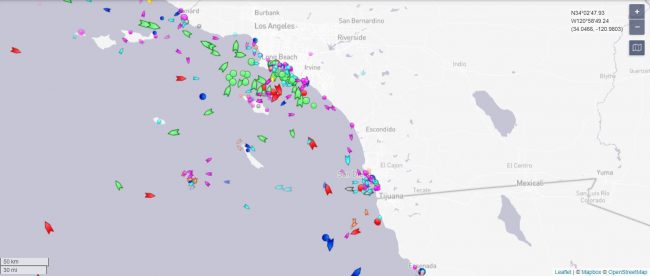A Major Problem Is Brewing At One Of Our Biggest Ports…
If you spend enough time in the markets, you’ll notice that everyone has a favorite indicator. Perhaps you even have a favorite or two of your own…
I’m always a little skeptical when someone tells me they have one that’s “foolproof” or infallible, and some I find to be more useful than others.
Yet, as my colleague Jimmy Butts has demonstrated recently, it pays to pay attention to the reliable ones.
In fact, I’ve developed an interest in a pet indicator of my own recently. I don’t know whether it will tell us anything definitive (yet), but I find it utterly fascinating. Want to know what it is?
It’s the number of ships waiting to enter the port of Long Beach, and the average wait time for them to enter.
The Long Beach Port Indicator
That may seem like an esoteric metric, but if you think about it, it can tell you a lot about the state of supply chains in the United States. As we all know, industries across the country have struggled to get things up and running, and there have been shortages of many items, from ammo to microchips, and more.
Now, Los Angeles and Long Beach are the largest and second-largest ports in the United States. They’re also the busiest. And in Long Beach in particular, the situation is dire. Last week, I pointed our premium readers to this article, from FrightWaves.com. At that time, a record 65 containerships were sitting in San Pedro Bay, just waiting to enter. And that’s just the beginning of the problem, because all those ships have to be unloaded, warehoused, and trucked off…
“How constrained is the flow? Port of Los Angeles Executive Director Gene Seroka said during a press conference on Wednesday that container dwell time in the terminal “has reached its peak since the surge began” and is now six days, worsening from 5.3 days last month. On-dock rail dwell time is 11.7 days, not far below the peak of 13.4. Street dwell time (outside the terminal) “is 8.5 days, nearing the all-time high” of 8.8 days, said Seroka. It has worsened from 8.3 days a month ago.”
Since I first raised this issue, the situation has only gotten worse. There are now 70 ships waiting in line. According to this piece, that’s a total capacity of 432,909 twenty-foot equivalent units. As they point out, for perspective, that’s more than the inbound container volume the Port of Long Beach handled in the entire month of August.
I encourage you to check out FreightWaves for more fascinating info, as well as MarineTraffic.com, where you can see up-to-the-minute satellite images of all of the ships just sitting in the bay waiting to enter.

Source: MarineTraffic
What This Means
This comes at a crucial time for retail in particular. Port authorities generally begin to see a spike in traffic at this time of year, in anticipation of the holiday shopping season. But this has to exacerbate what was already a dire situation. In a separate piece, the aforementioned Seroka was quoted in a Q&A summing up the situation in a rather frank way that doesn’t leave you feeling very encouraged…
“The railroads are full. The warehouses are full. Port terminals are full. Ships are coming in and waiting to get worked. The factories are behind in orders. This incredible demand has got everybody in the entire value chain just clipping out at levels we never could have imagined — and it’s still not enough.
“We’ve still got so much cargo coming in. We were on the phone with a big retailer this morning and they said that they’re still going to need another year to get inventories up to a level they think is appropriate.”
Seroka went on to detail how complex the situation is just in the port. A surge in demand, limited capacity, warehouse worker shortages, social distancing requirements, trucker shortages, outside factors contributing to those labor shortages (like enhanced stimulus benefits), the list goes on…
Action To Take
So let’s put this into context. We know there have been shortages for a while now. But will the situation materially impact retail sales in the all-important holiday season?
Only time will tell. But it may be a good idea to get your Christmas shopping done early this year. Also, be careful with any consumer spending and retail names as we enter the home stretch of 2021. Pay close attention to what executives are saying about inventory and supply chains, and don’t be surprised if they struggle to meet demand in the fourth quarter.
In the meantime, my colleague Nathan Slaughter anticipated this situation. He added a global marine shipping company to his High-Yield Investing portfolio back in January that is taking full advantage of sky-high charter rates. The stock has already more than doubled since then, but he still lists it as a “Buy First” recommendation to his readers.
You can go here now to learn more about Nathan’s service – and how to get your hands on this pick.
